engine HONDA PRELUDE 2000 (in English) Workshop Manual
[x] Cancel search | Manufacturer: HONDA, Model Year: 2000, Model line: PRELUDE, Model: HONDA PRELUDE 2000Pages: 293, PDF Size: 3.43 MB
Page 193 of 293
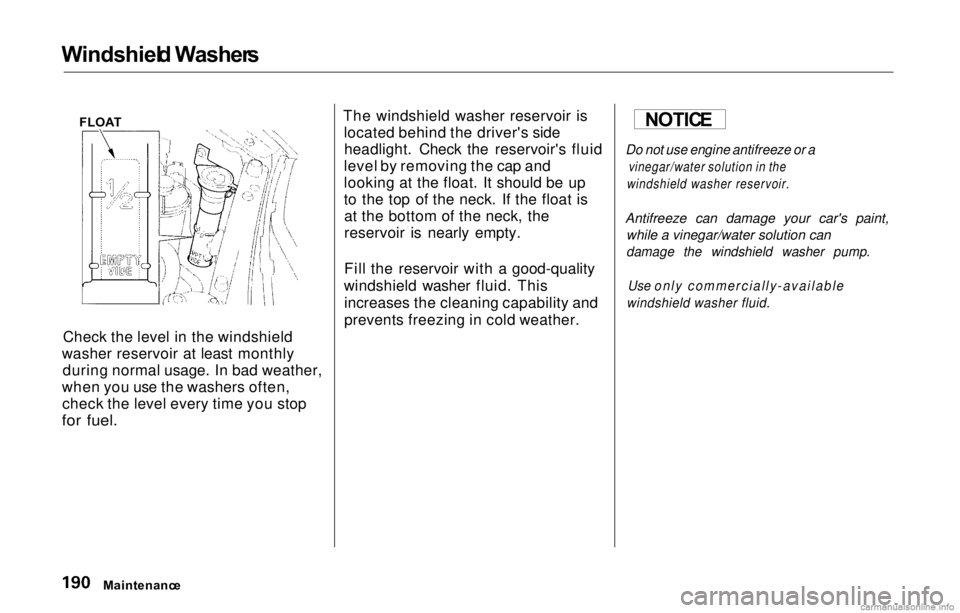
Windshiel
d Washer s
Check the level in the windshield
washer reservoir at least monthly during normal usage. In bad weather,
when you use the washers often, check the level every time you stop
for fuel.
The windshield washer reservoir is
located behind the driver's sideheadlight. Check the reservoir's fluid
level by removing the cap and
looking at the float. It should be up
to the top of the neck. If the float is at the bottom of the neck, the
reservoir is nearly empty.
Fill the reservoir with a good-quality
windshield washer fluid. This increases the cleaning capability and
prevents freezing in cold weather.
Maintenanc e
Do not use engine antifreeze or a
vinegar/water solution in the
windshield washer reservoir.
Antifreeze can damage your car's paint, while a vinegar/water solution can
damage the windshield washer pump.
Use
only commercially-available
windshield washer fluid.
FLOA
T NOTIC
E
Page 194 of 293
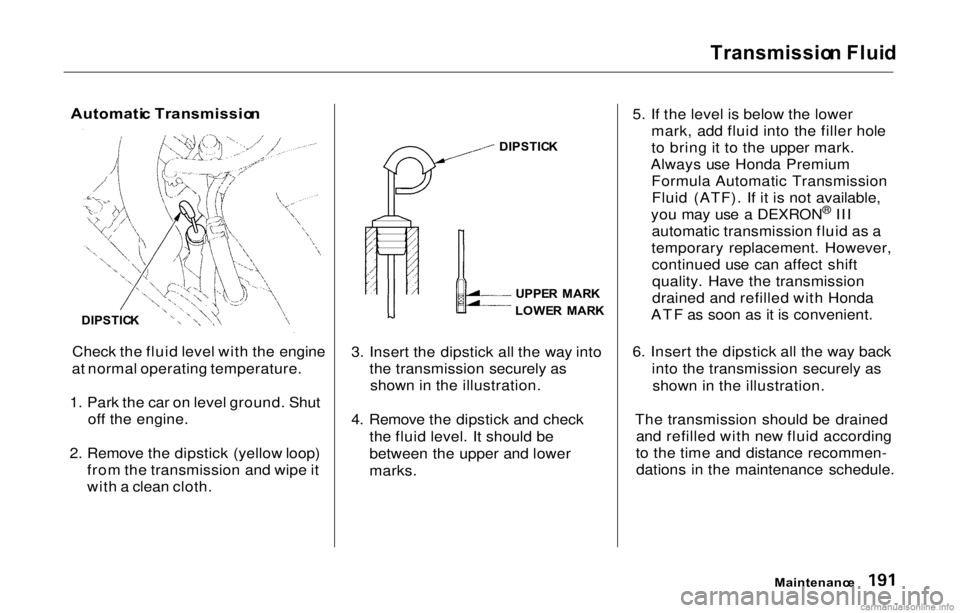
Transmissio
n Flui d
Automati c Transmissio n
Check the fluid level with the engine
at normal operating temperature.
1. Park the car on level ground. Shut off the engine.
2. Remove the dipstick (yellow loop) from the transmission and wipe it
with a clean cloth. 3. Insert the dipstick all the way into
the transmission securely asshown in the illustration.
4. Remove the dipstick and check the fluid level. It should be
between the upper and lower
marks. 5. If the level is below the lower
mark, add fluid into the filler hole
to bring it to the upper mark.
Always use Honda Premium Formula Automatic TransmissionFluid (ATF). If it is not available,
you may use a DEXRON ®
III
automatic transmission fluid as a
temporary replacement. However, continued use can affect shiftquality. Have the transmission
drained and refilled with Honda
ATF as soon as it is convenient.
6. Insert the dipstick all the way back into the transmission securely asshown in the illustration.
The transmission should be drained and refilled with new fluid according
to the time and distance recommen- dations in the maintenance schedule.
Maintenance
DIPSTIC
K
UPPE
R MAR K
LOWE R MAR K
DIPSTIC
K
Page 197 of 293
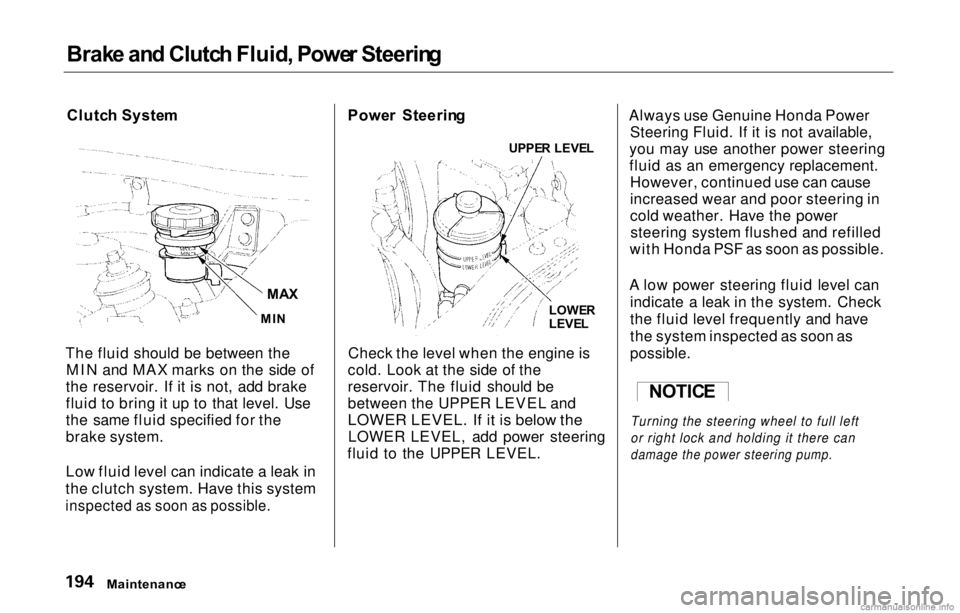
Brak
e an d Clutc h Fluid , Powe r Steerin g
Clutc h Syste m
The fluid should be between the MIN and MAX marks on the side of
the reservoir. If it is not, add brake
fluid to bring it up to that level. Use
the same fluid specified for the
brake system.
Low fluid level can indicate a leak in
the clutch system. Have this system
inspected as soon as possible.
Powe
r Steerin g
Check the level when the engine is
cold. Look at the side of the
reservoir. The fluid should be
between the UPPER LEVEL and
LOWER LEVEL. If it is below the
LOWER LEVEL, add power steering
fluid to the UPPER LEVEL. Always use Genuine Honda Power
Steering Fluid. If it is not available,
you may use another power steering
fluid as an emergency replacement. However, continued use can cause
increased wear and poor steering in
cold weather. Have the powersteering system flushed and refilled
with Honda PSF as soon as possible.
A low power steering fluid level can indicate a leak in the system. Check
the fluid level frequently and have
the system inspected as soon as
possible.
Maintenanc e
Turning the steering wheel to full left
or right lock and holding it there can
damage the power steering pump.
MA
X
MI N UPPE
R LEVE L
LOWE R
LEVE L
NOTICE
Page 198 of 293
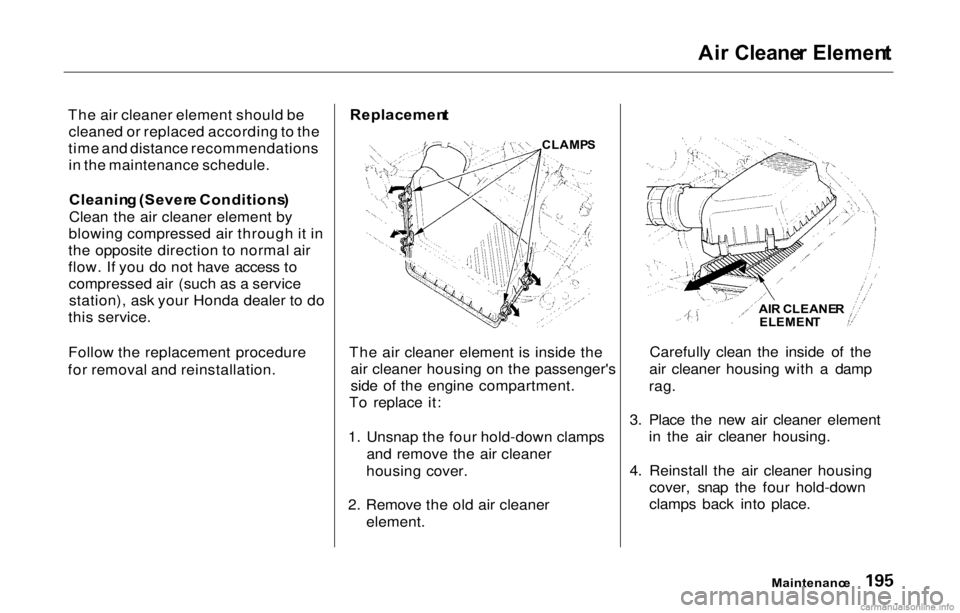
Ai
r Cleane r Elemen t
The air cleaner element should be cleaned or replaced according to the
time and distance recommendations in the maintenance schedule.
Cleanin g (Sever e Conditions )
Clean the air cleaner element by
blowing compressed air through it in
the opposite direction to normal air
flow. If you do not have access to compressed air (such as a servicestation), ask your Honda dealer to do
this service.
Follow the replacement procedure
for removal and reinstallation. Replacemen
t
The air cleaner element is inside the air cleaner housing on the passenger's
side of the engine compartment.
To replace it:
1. Unsnap the four hold-down clamps and remove the air cleaner
housing cover.
2. Remove the old air cleaner element. Carefully clean the inside of the
air cleaner housing with a damp
rag.
3. Place the new air cleaner element in the air cleaner housing.
4. Reinstall the air cleaner housing cover, snap the four hold-down
clamps back into place.
Maintenance
CLAMP
S
AIR CLEANE R
ELEMEN T
Page 201 of 293
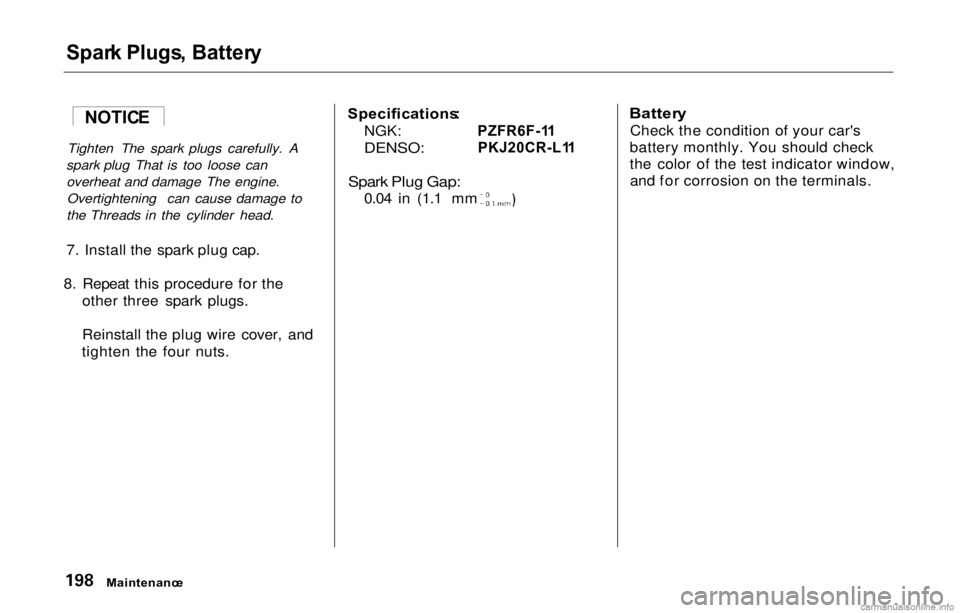
Spar
k Plugs , Batter y
Tighten The spark plugs carefully. A
spark plug That is too loose can overheat and damage The engine.Overtightening can cause damage to
the Threads in the cylinder head. Specifications
:
NGK:
DENSO:
Spark Plug Gap:
0.04 in (1.1 mm
PZFR6F-1
1
PKJ20CR-L1 1
Batter
y
Check the condition of your car's
battery monthly. You should check
the color of the test indicator window, and for corrosion on the terminals.
Maintenanc e
NOTIC
E
7. Install the spark plug cap.
8. Repeat this procedure for the other three spark plugs.
Reinstall the plug wire cover, and
tighten the four nuts.
Page 206 of 293
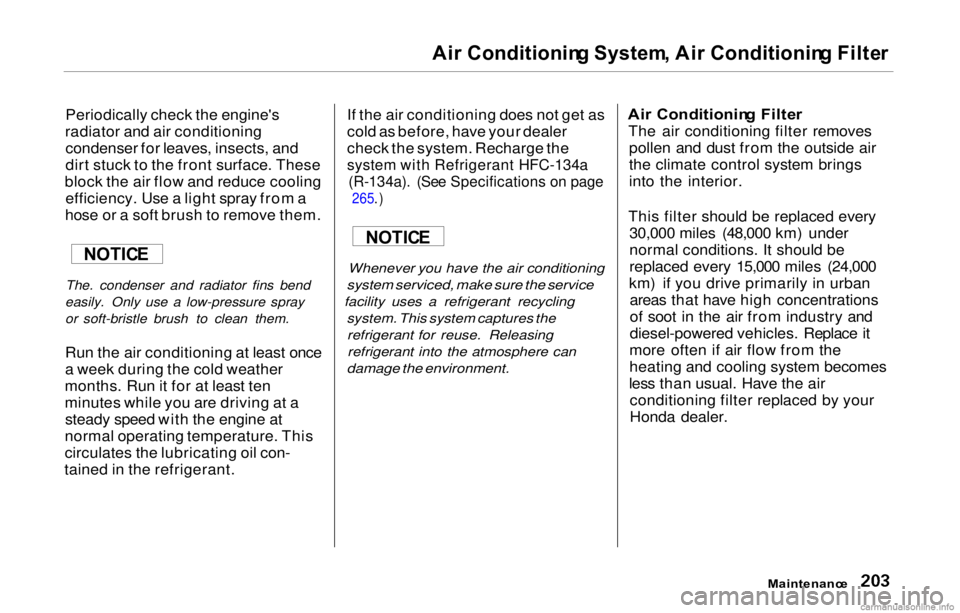
Ai
r Conditionin g System , Ai r Conditionin g Filte r
Periodically check the engine's
radiator and air conditioning condenser for leaves, insects, and
dirt stuck to the front surface. These
block the air flow and reduce cooling efficiency. Use a light spray from a
hose or a soft brush to remove them.
The. condenser and radiator fins bend
easily. Only use a low-pressure spray
or soft-bristle brush to clean them.
Run the air conditioning at least once
a week during the cold weather
months. Run it for at least ten
minutes while you are driving at a steady speed with the engine at
normal operating temperature. This
circulates the lubricating oil con-
tained in the refrigerant. If the air conditioning does not get as
cold as before, have your dealer
check the system. Recharge the
system with Refrigerant HFC-134a
(R-134a). (See Specifications on page
265.)
Whenever you have the air conditioning
system serviced, make sure the service
facility uses a refrigerant recycling
system. This system captures the
refrigerant for reuse. Releasing
refrigerant into the atmosphere can
damage the environment.
Ai
r Conditionin g Filte r
The air conditioning filter removes pollen and dust from the outside air
the climate control system brings
into the interior.
This filter should be replaced every 30,000 miles (48,000 km) under
normal conditions. It should be
replaced every 15,000 miles (24,000
km) if you drive primarily in urban areas that have high concentrations
of soot in the air from industry and
diesel-powered vehicles. Replace it
more often if air flow from the
heating and cooling system becomes
less than usual. Have the air conditioning filter replaced by your
Honda dealer.
Maintenance
NOTIC
E NOTIC
E
Page 228 of 293
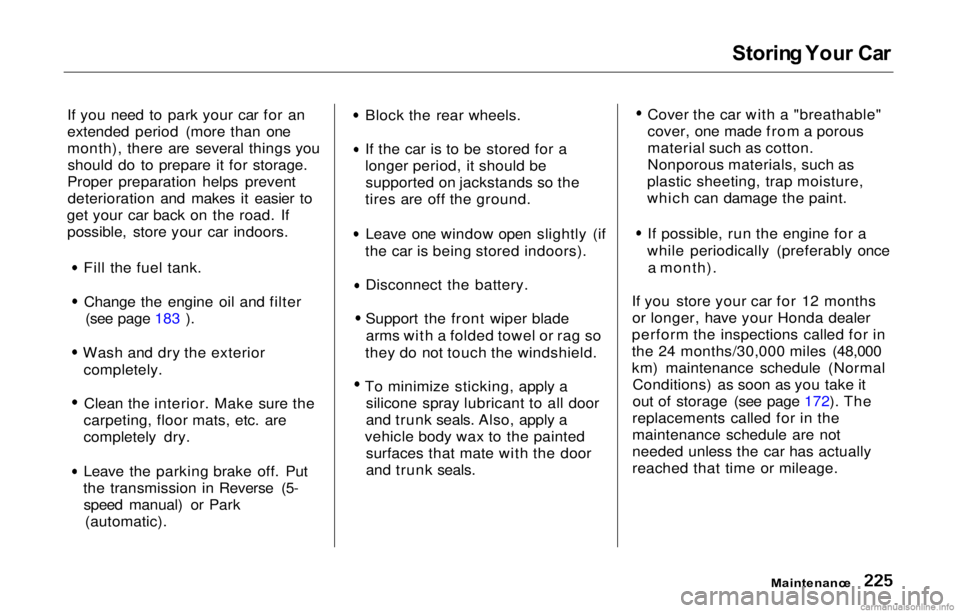
Storin
g You r Ca r
If you need to park your car for an
extended period (more than one
month), there are several things you should do to prepare it for storage.
Proper preparation helps prevent deterioration and makes it easier to
get your car back on the road. If possible, store your car indoors. Fill the fuel tank.
Change the engine oil and filter
(see page 183 ). Wash and dry the exterior
completely. Clean the interior. Make sure the
carpeting, floor mats, etc. are
completely dry. Leave the parking brake off. Put
the transmission in Reverse (5- speed manual) or Park (automatic). Block the rear wheels.
If the car is to be stored for a
longer period, it should be
supported on jackstands so the
tires are off the ground. Leave one window open slightly (if
the car is being stored indoors). Disconnect the battery.
Support the front wiper blade
arms with a folded towel or rag so
they do not touch the windshield. To minimize sticking, apply a
silicone spray lubricant to all door
and trunk seals. Also, apply a
vehicle body wax to the painted surfaces that mate with the door
and trunk seals. Cover the car with a "breathable"
cover, one made from a porous
material such as cotton.
Nonporous materials, such as
plastic sheeting, trap moisture,
which can damage the paint. If possible, run the engine for a
while periodically (preferably once a month).
If you store your car for 12 months or longer, have your Honda dealer
perform the inspections called for in
the 24 months/30,000 miles (48,000
km) maintenance schedule (Normal Conditions) as soon as you take it
out of storage (see page 172). The
replacements called for in the
maintenance schedule are not
needed unless the car has actually
reached that time or mileage.
Maintenance
Page 238 of 293
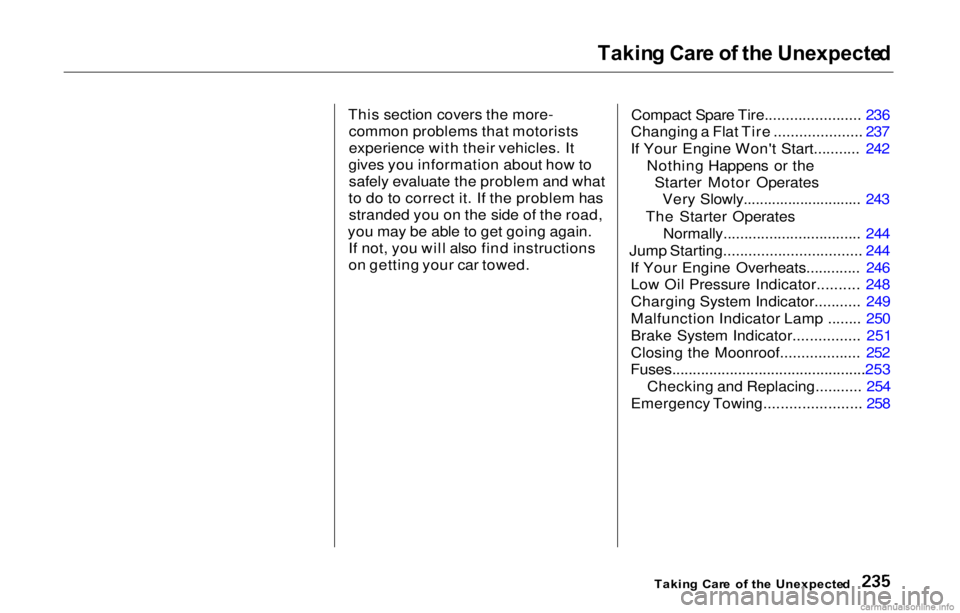
Takin
g Car e o f th e Unexpecte d
This section covers the more- common problems that motorists
experience with their vehicles. It
gives you information about how to safely evaluate the problem and what
to do to correct it. If the problem has stranded you on the side of the road,
you may be able to get going again. If not, you will also find instructions
on getting your car towed. Compact Spare Tire....................... 236
Changing a Flat Tire ..................... 237
If Your Engine Won't Start........... 242
Nothing Happens or theStarter Motor OperatesVery Slowly............................. 243
The Starter Operates Normally................................. 244
Jump Starting................................. 244 If Your Engine Overheats............. 246Low Oil Pressure Indicator.......... 248
Charging System Indicator........... 249
Malfunction Indicator Lamp ........ 250
Brake System Indicator................ 251
Closing the Moonroof................... 252
Fuses...............................................253
Checking and Replacing........... 254
Emergency Towing....................... 258
Takin g Car e o f th e Unexpecte d
Page 245 of 293
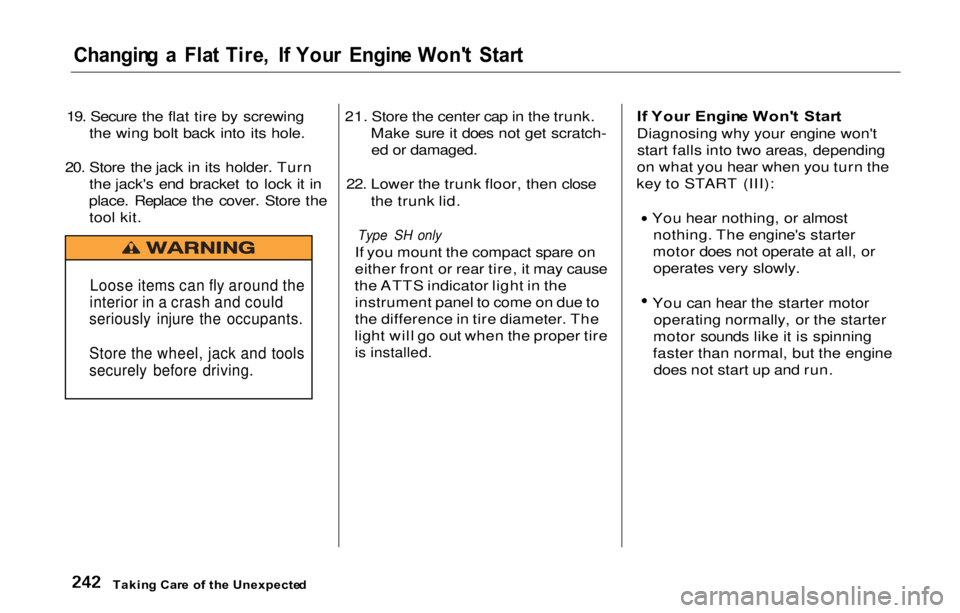
Changing a Fla t Tire , I f You r Engin e Won' t Star t
19. Secure the flat tire by screwing
the wing bolt back into its hole.
20. Store the jack in its holder. Turn the jack's end bracket to lock it in
place. Replace the cover. Store the tool kit. 21. Store the center cap in the trunk.
Make sure it does not get scratch-ed or damaged.
22. Lower the trunk floor, then close the trunk lid.
Type SH only
If you mount the compact spare on
either front or rear tire, it may cause
the ATTS indicator light in the instrument panel to come on due to
the difference in tire diameter. The
light will go out when the proper tire
is installed.
I f You r Engin e Won' t Star t
Diagnosing why your engine won't start falls into two areas, depending
on what you hear when you turn the
key to START (III):
You hear nothing, or almost nothing. The engine's starter
motor does not operate at all, or operates very slowly.
You can hear the starter motor operating normally, or the starter
motor sounds like it is spinning
faster than normal, but the engine does not start up and run.
Takin g Car e o f th e Unexpecte d
Loose items can fly around the
interior in a crash and could
seriously injure the occupants.
Store the wheel, jack and tools
securely before driving.
Page 246 of 293
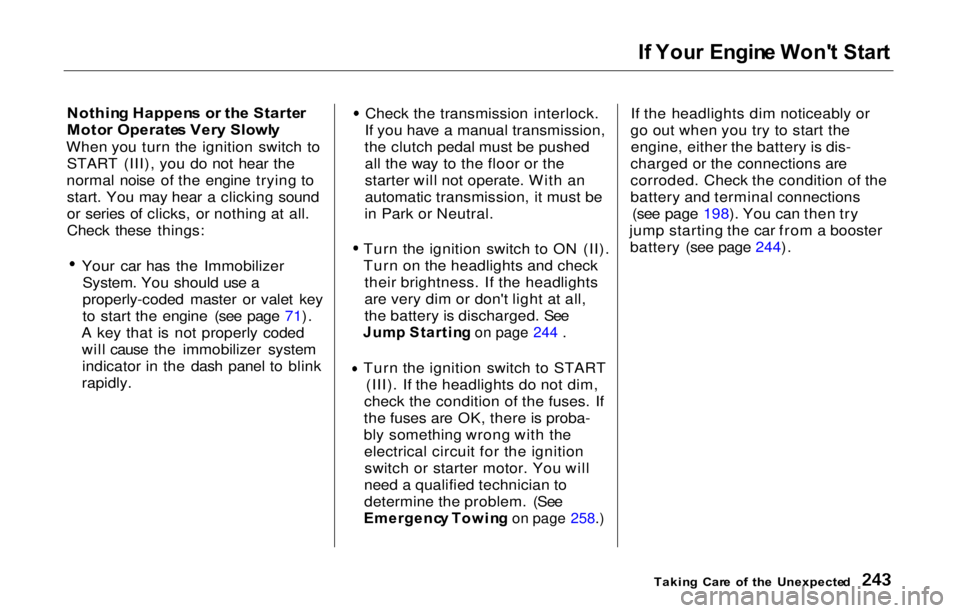
I
f You r Engin e Won' t Star t
Nothin g Happen s o r th e Starte r
Moto r Operate s Ver y Slowl y
When you turn the ignition switch to START (III), you do not hear the
normal noise of the engine trying to start. You may hear a clicking sound
or series of clicks, or nothing at all.
Check these things: Your car has the Immobilizer
System. You should use a
properly-coded master or valet key
to start the engine (see page 71).
A key that is not properly coded will cause the immobilizer systemindicator in the dash panel to blink
rapidly. Check the transmission interlock.
If you have a manual transmission,
the clutch pedal must be pushed all the way to the floor or the
starter will not operate. With an
automatic transmission, it must be
in Park or Neutral. Turn the ignition switch to ON (II).
Turn on the headlights and check
their brightness. If the headlights
are very dim or don't light at all,
the battery is discharged. See
Jum p Startin g on page 244 .
Turn the ignition switch to START
(III). If the headlights do not dim,
check the condition of the fuses. If
the fuses are OK, there is proba-
bly something wrong with the electrical circuit for the ignitionswitch or starter motor. You will
need a qualified technician to
determine the problem. (See
Emergenc y Towin g on page 258.)
If the headlights dim noticeably or
go out when you try to start the engine, either the battery is dis-
charged or the connections are
corroded. Check the condition of the
battery and terminal connections (see page 198). You can then try
jump starting the car from a booster battery (see page 244).
Takin g Car e o f th e Unexpecte d